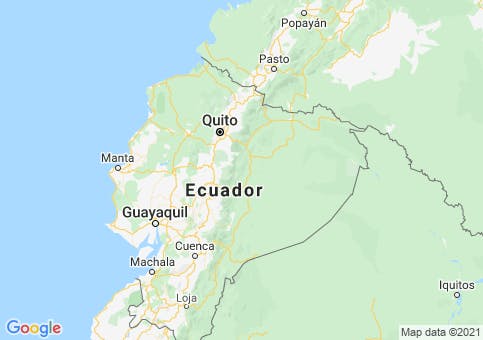One of the great perks for foreign residents living in Ecuador is high-quality, low-cost healthcare. Bloomberg recently rated Ecuador as having the 20th most efficient healthcare system among advanced economies, while the U.S. ranked near the bottom in 46th place.
An internet comparison of healthcare costs from around the world found that Ecuador’s costs are the lowest—lower than those in China, Malaysia, India, Mexico, and Panama. In general, you can expect to pay 10% to 25% of what you would in the U.S. For major surgery, we’ve seen a number of cases in which costs were even less than 10% of comparable procedures in the U.S. You will find similar savings for dental care.
Although Ecuador is a developing country, you will find first-rate medical care here, particularly in the major cities. Many doctors are educated in the U.S., Europe, Argentina, Chile, and Cuba and continue to train around the world. In many respects, the medical system is reminiscent of that in the U.S. in the 1950s or 1960s. House calls are still possible, most doctors do not have nurses, and the average office visit is 30 to 45 minutes. Another throwback is that Ecuadorian doctors don’t expect to become instant millionaires, and the average income for doctors, according a Quito medical association, is about $65,000 a year.
A visit to a general practitioner costs $20 to $35, while a visit to a specialist runs anywhere from $40 to $80. For follow-up visits there is usually no charge at all. A psychiatrist will charge $40 to $50 for a half-hour session. Simple, ambulatory procedures are equally inexpensive. For example, the removal of a small lump (under local anesthesia) and a biopsy cost about $125. Brand name medicines usually cost less than in the U.S. Generics, which are widely available, are also much cheaper.
Health Insurance in Ecuador
In 2017, Ecuador passed new laws making some type of health insurance mandatory for all citizens under 65 years of age, and all residents under 65 who had their visas registered after February 6, 2017. However, laws were also passed making it illegal for private insurance companies to exclude clients based on age, sex, or pre-existing conditions.
Health insurance remains a bargain in Ecuador. A review of comparable insurance policies for a 60-year-old man in the U.S. and Ecuador tells the story. In the U.S., the man would pay a monthly premium of $1,200; in Ecuador, he may pay as little as $70. A woman age 50 to 60 would pay $72 for the same policy in Ecuador, while coverage for a dependent child, between two and 17 years of age, costs $15.69 a month.
The policy cited is offered by Salud S.A. (website: https://www.saludsa.com), Latin America’s largest health insurance company, and pays 80% of doctor’s visits, 60% of medication costs, and 100% of hospitalizations. It also offers extra coverage for walk-in procedures and accidents.
Although international health insurance is available from several local companies, costs can be considerably higher than Ecuadorian policies. Keep in mind that international policies must cover such high-priced countries as the U.S.
The Social Security Healthcare Option
Ecuador has invested hundreds of millions of dollars to upgrade its national social security healthcare system (Instituto Ecuatoriano de Seguridad Social, or IESS) and as of January 2014 allowed foreign residents of any age a “buy-in” option. Following a change in 2017, expats now must provide proof of income in order for the rate of their IESS insurance to be set. If your visa was based on your pension, that figure will be used. For other types of visas, you will need to provide documentation to verify your income.
The rates for IESS coverage are based on the income claimed. The primary enrollee (and it can be either spouse) will pay a monthly fee equal to 17.6% of their income. A spouse and other family members may be added for an additional 3.41% per month. So if you have a pensioner’s visa for the minimum amount ($800 + $100 for dependents), your monthly fee as a couple would be $168.08. Keep in mind you don’t need to disclose all of your income, just what you are claiming to participate.
This is still a bargain, as the public healthcare system covers in-hospital care, outpatient care, extended care, home care, prescription drugs, dental care, and eye care. Again, please note that the healthcare regulations are still under debate and could change at any time. Keep up with International Living for up-to-date information as this develops.
Dental Care in Ecuador
Dental care in Ecuador is also a bargain, costing 80% to 90% less than similar care in the United States. As with physicians, you will find that most dentists are well trained and have access to the latest technology. Many of them also speak English.
Checking prices for dental care, a cleaning costs $30 to $45. Cavity repairs and fillings cost $25 to $35. Partial plates cost $325 and a complete set of dentures costs about $900, including office visits, fittings, lab work, and impressions.
My Experience Getting Private Healthcare in Ecuador

By Fiona Mitchell
Sitting anxiously in the ophthalmologist’s waiting room in Cuenca, I kept trying to pronounce in my head the 10-syllable Spanish word for the test I was about to undergo.
Although I speak Spanish pretty well, this word was definitely testing my linguistic skills. But what struck me more than the improbability of being able to get my tongue around angiofluoresceinografía, (fluorescein angiography) was how easy it had been to schedule this particular eye exam, and many other medical appointments I’d had within the past few weeks.
So, how did I end up in this Ecuadorian ophthalmologist’s waiting room? My husband and I had moved to our adopted city of Cuenca in October 2019, after I’d finally persuaded him that relocating to South America would be a great idea. I’d dragged him away from our comfortable life in Colorado on an 18-month exploratory trip through Mexico, Colombia, and Ecuador, and we’d settled on Ecuador as the most livable of the three.Many doctors here have studied in the U.S.High-quality healthcare was a key reason that this small country prevailed—many doctors here have studied or trained in the U.S. or Europe at some point during their careers—but I had no idea then that I would become such a frequent flyer within the country’s private healthcare system.
Shortly after relocating, I began to experience vision problems. Everything seemed too bright, though I initially thought this was an effect of the intense equatorial sun. Cuenca lies at 8,500 feet above sea level, so the sunlight is harsh.
Even though the temperatures are very comfortable in Cuenca, with an almost constant daytime high of around 75 F, the sun can be intense. I put my eye problems down to that, initially. Over time, though, other disconcerting visual phenomena started to occur, causing me to seek out ophthalmological advice.
My primary care doctor in Cuenca recommended a highly respected retinologist, and to my surprise, instructed me to contact him by WhatsApp. Surely, I thought, I can’t just send a WhatsApp message to a doctor! It can’t be that easy, can it? I was skeptical, to say the least.
I felt a little sheepish typing out a text message to the doctor, but was amazed when I received an immediate response asking me to see him the following day. A short texting duel ensued, and I learned that a consultation would cost $40; that his office was just a $2 taxi ride away (he helpfully included a Google Maps pindrop for the location); and that I should bring my Ecuadorian residence card with me. All very civilized and straightforward. I couldn’t believe that I was communicating directly with the doctor, instead of going through a receptionist or secretary.
So, off I went to my first appointment, and I was immediately impressed by the modern facilities, high-tech equipment, and obvious experience of the attending doctor. He gave me at least 30 minutes of his time, and it never felt as though he was trying to rush to his next patient (an experience I’ve regularly had in the States).
He advised me to undergo further diagnostic tests, all of which were available at the same facility, and which I was able to schedule over the following weeks. Each test or scan was incredibly easy to arrange, usually by direct phone contact with the specialist. Although I conducted all my business in Spanish, I frequently heard the doctors and their staff communicating with other expats in English. After every test, I received the results on the same day, and was able to follow up with the doctor for no additional cost.
Speaking of costs, the most expensive eye exam I underwent cost $110 (an electroretinogram), and the majority were in the range of $50 to $90. Outpatient care in Ecuador is typically paid for upfront, unlike in the States. Each appointment with a specialist cost between $40 and $50, and this was also true for the other consultants I ended up seeing outside of the field of ophthalmology.
I found most providers expected to be paid in cash, although I was occasionally able to use a debit card for larger payments. A helpful tip is to keep every receipt for any payments made, as well as any original orders from the doctor/specialist requesting diagnostic tests. These are all essential when making insurance claims later on.
After completing numerous ophthalmological exams, I was referred to a new field: neurology. Once again, I was able to directly schedule appointments with a highly recommended neurologist via WhatsApp. This led me into the world of MRI scans. I’d always figured that you had more chance of being granted an audience with the president than of ever getting an MRI appointment. So, imagine my amazement when I was able to pop into the hospital imaging department straight after my neurology consultation and book a brain scan for the following day.Expect to pay a monthly premium of $50 to $150.Better still, the total cost was just $290. I believe that is considerably less than the cost of an MRI scan in the States.
As I had by then come to expect, the equipment was state-of-the-art, well-maintained, and comparable to anything I’d seen in the U.S. The technician was very reassuring and did a great job of keeping me calm since I get a little claustrophobic in these coffin-like contraptions. Most impressively, I received my results, including the radiologist’s report and printed images, that same day.
Having the actual images in my own hands was extremely helpful, as I was able to take them to future appointments with other specialists. And I did see several more specialists in my quest for a diagnosis.
While I haven’t been able to get any resolution for my vision problems yet, a recent trip to the U.S. for a second opinion yielded no further answers, and confirmed that the doctors in Ecuador have been thorough and doing everything right.

Having direct access to doctors and specialists has removed much of the stress from an otherwise worrying time in my life. My doctors have even been happy to respond to voice messages regarding minor questions or concerns, reducing the number of in-person consultations I’ve had to pay for.
I’ve always been treated with compassion and empathy here, and have never had to worry about waiting for weeks (or even months) to receive test results or schedule follow-up appointments. Regardless of what may come, my knowledge of Spanish medical terminology has grown immeasurably, and the once-impossible angiofluoresceinografia practically trips off my tongue!
Ecuador is the fourth country I’ve lived in (the others being the U.K., U.S., and Bolivia) and it has offered by far the best access to excellent and affordable healthcare. Part of the immigration requirement when applying for Ecuadorian residency is that you provide proof of health insurance.
This generally means that you will need to buy an insurance plan from an Ecuadorian provider, since most U.S. insurers won’t cover you if you live here. There are plenty of Ecuadorian private insurance providers to choose from.
For a general idea of costs, a reasonably healthy person between 50 and 70 years old can expect to pay a monthly premium in the range of $50 to $150. This will provide good coverage, with a modest annual deductible (often less than $500) and cover at least 75% of out-of-pocket costs.
This article deals exclusively with my experience using the country’s private healthcare system. Ecuador’s public system falls under the umbrella of the national social security entity, the IESS.
The IESS system also allows expat residents to buy into it, paying a monthly fee (about $75) that then entitles them to free healthcare (including dental) within the IESS network. I don’t have personal experience with this, but many expats choose this option and are very satisfied with the care they’ve received.
So far, all of my healthcare here in Ecuador has been as an outpatient, but from discussions with friends who have undergone major surgeries in Cuenca—including double hip replacements, hernia repairs, cataract surgeries, and lung/abdominal tumor removals—most inpatient procedures cost one-tenth to one-fifth of what they would cost in the U.S.
In each case, the care was excellent (generally communicated in English) and their surgeries have been successful. The only downside to be aware of is that you may have to be your own advocate somewhat when it comes to post-surgery care. For example, you may have to be proactive about ensuring that you have a sufficient supply of pain medication, or in establishing follow-up treatment such as physical therapy. Some of the standard protocol you would expect after surgery in the U.S. is not necessarily commonplace here.
Having said that, many foreigners, particularly those from the U.S., actually come to Ecuador for medical tourism vacations, knowing that they can receive high-class care here for a fraction of what it would cost in their home countries.
While my hope is that you don’t need to use the country’s healthcare system while you live here, it’s good to know that there are excellent resources available if it does come to that!
Get Your Free Ecuador Report Here
Get Your Free Ecuador Report Here
Learn more about Ecuador and other countries in our daily postcard e-letter. Simply enter your email address below and we'll send you a FREE REPORT - Ecuador: Live Like Royalty on Your Social Security.

By submitting your email address, you will receive a free subscription to IL Postcards, Overseas Dream Home, The Untourist Daily and special offers from International Living and our affiliates. You can unsubscribe at any time, and we encourage you to read more about our Privacy Policy.












